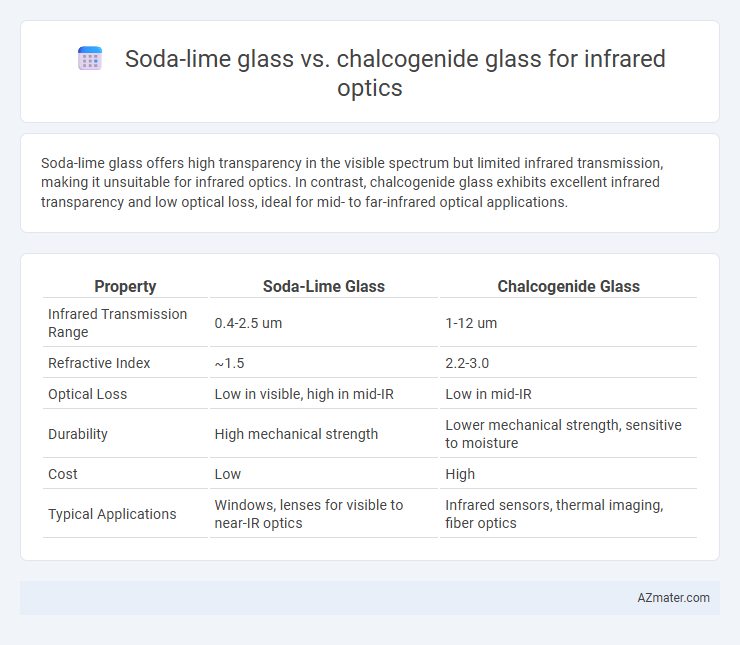Soda-lime glass offers high transparency in the visible spectrum but limited infrared transmission, making it unsuitable for infrared optics. In contrast, chalcogenide glass exhibits excellent infrared transparency and low optical loss, ideal for mid- to far-infrared optical applications.
Table of Comparison
| Property | Soda-Lime Glass | Chalcogenide Glass |
|---|---|---|
| Infrared Transmission Range | 0.4-2.5 um | 1-12 um |
| Refractive Index | ~1.5 | 2.2-3.0 |
| Optical Loss | Low in visible, high in mid-IR | Low in mid-IR |
| Durability | High mechanical strength | Lower mechanical strength, sensitive to moisture |
| Cost | Low | High |
| Typical Applications | Windows, lenses for visible to near-IR optics | Infrared sensors, thermal imaging, fiber optics |
Introduction to Infrared Optics: Material Choices
Soda-lime glass, widely used in visible optics, exhibits limited infrared transmission beyond 2.5 microns, making it unsuitable for many infrared applications. Chalcogenide glass, composed of sulfur, selenium, and tellurium, offers excellent transmission in the mid- to far-infrared range (2 to 12 microns), essential for advanced IR optics. Material selection for infrared optics prioritizes transmission range, refractive index, and thermal stability, with chalcogenide glass providing superior performance for thermal imaging and spectroscopy.
Soda-Lime Glass: Composition and Properties
Soda-lime glass primarily consists of silica (SiO2), sodium oxide (Na2O), and calcium oxide (CaO), offering high chemical durability and optical clarity in the visible spectrum but limited infrared transmission beyond 2.5 microns. Its relatively low cost and mechanical strength make it suitable for standard optical components, though it has a lower refractive index and higher absorption losses in the mid-infrared range compared to chalcogenide glass. Unlike chalcogenide glass, which contains sulfur, selenium, or tellurium for enhanced infrared transparency, soda-lime glass is less effective for infrared optics requiring transmission beyond 3 microns.
Chalcogenide Glass: Composition and Infrared Advantages
Chalcogenide glass, composed primarily of sulfur, selenium, and tellurium, exhibits superior infrared transmission compared to soda-lime glass, which is mainly silica-based and opaque beyond 2.5 microns. Its unique composition enables high transparency across the mid-infrared range (2-12 microns), critical for advanced infrared optics such as thermal imaging and spectroscopy. This glass type also offers enhanced refractive indices and nonlinear optical properties, making it ideal for infrared lenses, waveguides, and photonic devices.
Transmission Ranges: Visible vs Infrared Capabilities
Soda-lime glass exhibits strong transmission in the visible spectrum (approximately 400-700 nm) but has limited infrared transmission, effectively blocking wavelengths beyond 2.5 microns. Chalcogenide glass extends transmission well into the mid-infrared range, typically spanning 1 to 15 microns, making it ideal for infrared optics applications such as thermal imaging and fiber optics. The broad infrared transparency of chalcogenide glass contrasts with the visible-range limitation of soda-lime glass, determining their respective roles in optical system design.
Thermal Stability and Environmental Resistance Comparison
Soda-lime glass exhibits lower thermal stability compared to chalcogenide glass, with a softening point around 550degC versus chalcogenide's higher resistance often exceeding 300degC in infrared optic applications. Chalcogenide glass demonstrates superior environmental resistance due to its high sulfur, selenium, or tellurium content, providing enhanced chemical durability and reduced moisture absorption relative to soda-lime glass. These attributes make chalcogenide glass more suitable for demanding infrared optics requiring long-term thermal stability and resistance to environmental degradation.
Optical Performance in IR Applications
Soda-lime glass exhibits limited infrared transmission, typically blocking wavelengths beyond 2.5 microns, making it unsuitable for advanced IR optics requiring clarity in the mid to long-wave IR range. Chalcogenide glass offers superior infrared optical performance with high transmission from 1 to 12 microns and low dispersion, essential for precise IR imaging and sensing applications. Its chemical composition allows for tunable refractive indices and enhanced durability under IR exposure, outperforming soda-lime glass in thermal and spectral stability.
Manufacturing and Cost Considerations
Soda-lime glass, widely used in general optics, is cost-effective and benefits from mature, low-cost manufacturing processes suitable for large-scale production, but it has limited transmission in the infrared spectrum beyond 2.5 microns. Chalcogenide glass, composed of sulfur, selenium, and tellurium compounds, offers superior infrared transmission up to 12 microns, making it ideal for IR optics despite higher raw material costs and more complex manufacturing due to its sensitivity to moisture and thermal instability. Investment in specialized fabrication techniques such as controlled atmosphere melting and precision polishing increases the cost of chalcogenide glass components, positioning soda-lime glass as the economical choice for visible to near-IR applications and chalcogenide glass for mid- to far-IR requirements.
Durability, Hardness, and Mechanical Strength
Chalcogenide glass exhibits superior infrared transmission compared to soda-lime glass, making it ideal for IR optic applications. It generally offers enhanced mechanical strength and better durability in harsh environments, while soda-lime glass is more brittle and prone to surface damage. However, soda-lime glass has higher hardness, but its limited IR transparency restricts its use in advanced infrared optics.
Typical Applications in Infrared Technologies
Soda-lime glass, with limited infrared transmission, is primarily used in visible optics and low-cost applications but is unsuitable for advanced infrared technologies. Chalcogenide glass exhibits excellent transmission in the mid-infrared range (2-12 microns), making it ideal for infrared sensors, thermal imaging, and fiber optic components in IR spectroscopy. The superior infrared transparency and low phonon energy of chalcogenide glass enable high-performance infrared optical devices in defense, medical diagnostics, and environmental monitoring.
Choosing the Right Glass for Infrared Optics
Soda-lime glass has limited infrared transmission, typically effective only up to around 2.5 microns, making it less suitable for advanced infrared optics compared to chalcogenide glass, which offers excellent transparency across mid- to far-infrared wavelengths from about 2 to 12 microns. Chalcogenide glasses possess higher refractive indices and lower phonon energies, enhancing infrared performance and enabling precise thermal imaging and sensing applications. Selecting chalcogenide glass over soda-lime glass is essential when designing optical components for robust infrared detection, spectroscopy, and thermal cameras.

Infographic: Soda-lime glass vs Chalcogenide glass for Infrared optic
 azmater.com
azmater.com